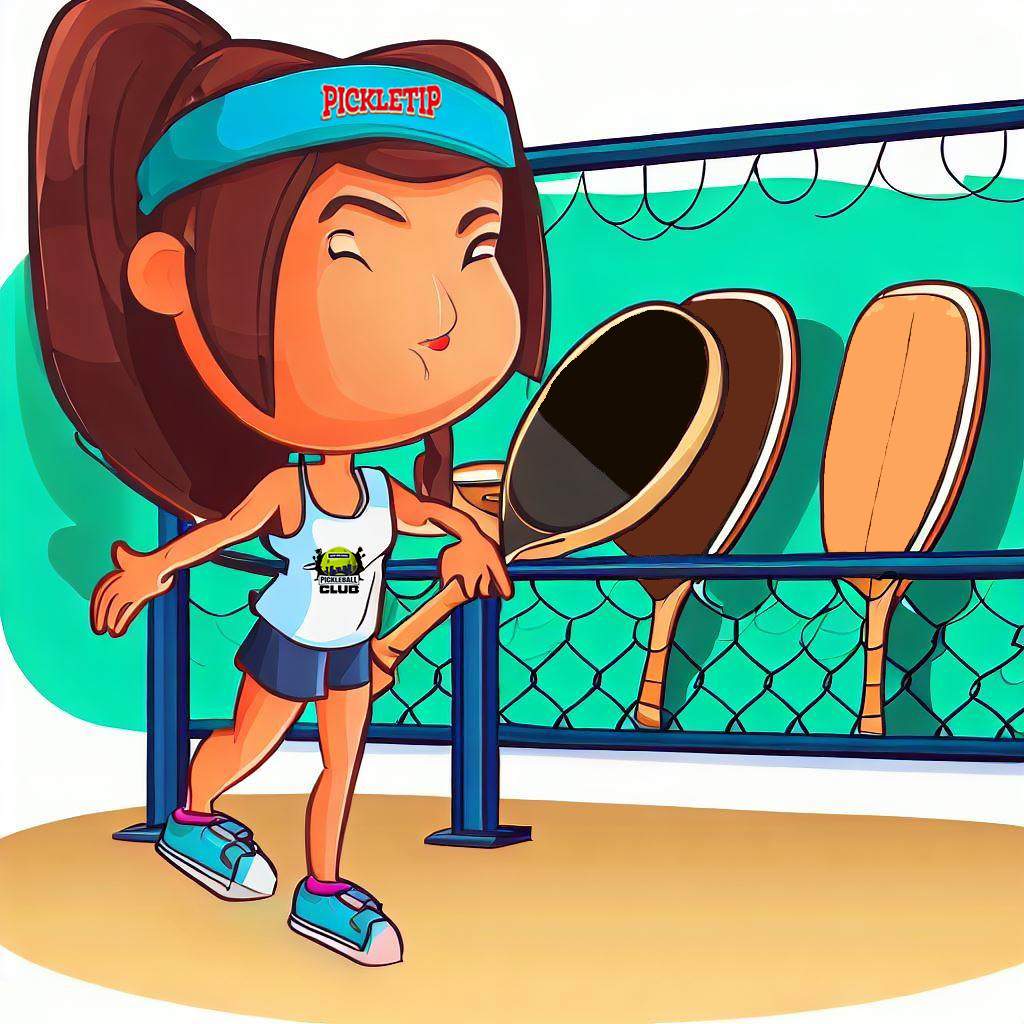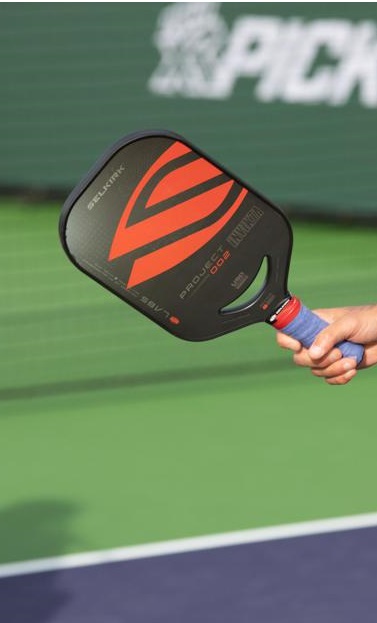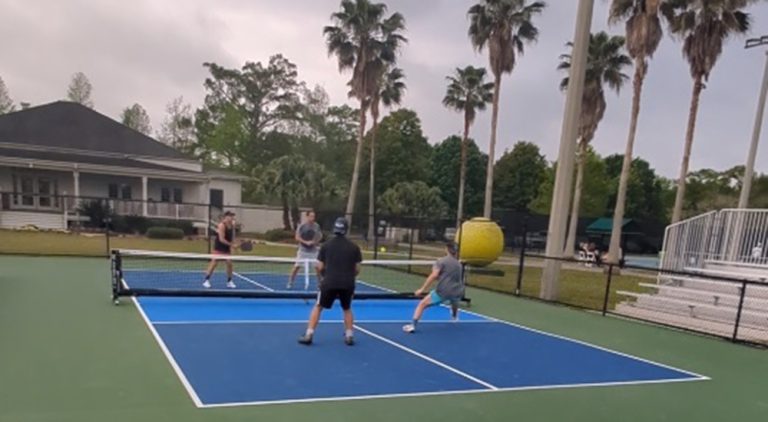Paddle Stacking in Pickleball
The concept of paddle stacking in pickleball is a method used to manage the rotation of players during open play sessions. In recreational or open play sessions, especially when courts are busy and there are many players waiting to get on the court, paddle stacking is a common practice to determine the order of play.

How Paddle Stacking Works
Players who are waiting to play will place (or “stack”) their paddles in a designated area, often on the side of the court or in special paddle racks. This is typically done in groups of four since pickleball doubles is the most common format. The order in which the paddles are stacked determines the order of play. The first group of four paddles represents the next group to play on a court when it becomes available.
Rotation and Fair Play
Once a game finishes and a court becomes available, the next group of four players (as determined by the stacked paddles) will take the court. The previous players will either rest or, if they wish to play again, place their paddles at the end of the line. This system ensures a fair rotation and allows everyone an opportunity to play. It’s especially useful during busy times when there are more players than available courts.
Variations in Paddle Stacking
Some venues might have variations of this system, such as different rules for winners staying on or incorporating challenge courts, but the basic principle of paddle stacking remains the same. This system is a simple and effective way to manage court rotations and ensure that everyone gets a chance to play in a fair and organized manner.
Paddle Stacking in Detail
Purpose
The primary purpose of paddle stacking is to maintain an organized rotation of players, ensuring that everyone gets an equal opportunity to play, especially during peak times when courts are bustling with activity.
Procedure
Players waiting for their turn will place their paddles in the designated area. As courts become available, the next set of paddles in line will indicate the next group of players. This system is predominantly used for doubles play, which requires four players.
Duration of Play
Typically, each game lasts until one team scores 11 points with a win by 2. After the game, players vacate the court for the next set of players.
Advantages
Paddle stacking eliminates confusion about who’s next in line to play. It also prevents the same group of players from dominating the court for extended periods.
FAQs about Paddle Stacking
Q: What if I want to play with specific players?
A: You can arrange your paddles together in the stacking area. However, it’s essential to respect the order and not jump the queue.
Q: What happens if there are more than four paddles stacked together?
A: Only the first four paddles in the stack will play the next game. Any additional paddles will form the subsequent groups.
Q: Can singles players use the paddle stacking system?
A: While paddle stacking is primarily for doubles, singles players can also use the system. They would just need to wait for another singles player to join them.
Q: Is paddle stacking used in tournaments?
A: No, paddle stacking is mainly for recreational or open play sessions. Tournaments have their own structured scheduling and bracketing systems.
Q: What if someone moves my paddle or disrupts the order?
A: It’s essential to maintain sportsmanship and respect in pickleball. If you suspect someone has moved your paddle, it’s best to communicate openly and resolve the issue amicably.
Q: Are there any alternatives to paddle stacking?
A: Some venues might use sign-up sheets or electronic systems, especially if they have multiple courts. However, paddle stacking remains a popular and straightforward method.
Additional Points to Understand about Paddle Stacking
Paddle Identification
New players should ensure their paddles are easily identifiable. Some players use colored grip tape, stickers, grip bands, or write their initials on the handle to distinguish their paddle from others. This helps in quickly recognizing one’s paddle in the stack.
Joining Mid-Session
If a player arrives in the middle of a session and wants to join the rotation, they should place their paddle at the end of the current stack. It’s considered good etiquette to wait for the current rotation to finish before joining in.
Stacking Etiquette
Players should avoid rearranging the paddle stack to favor themselves or their friends. This disrupts the order and can lead to disputes. Always respect the order in which paddles were placed.
Communication
If a player is unsure about the stacking system or their position in the rotation, they should ask. Regular players or court organizers are usually happy to explain the process.
Leaving the Rotation
If a player needs to take a break or leave, they should remove their paddle from the stack. If they wish to rejoin later, their paddle goes to the end of the line.
Different Stacking Systems
Some venues might use a color-coded system or numbered paddles to manage rotations, especially during organized play sessions or clinics. New players should familiarize themselves with these systems if they exist.
Respect the Court’s Rules
Some courts might have specific rules about game duration during peak times to ensure everyone gets a chance to play. For instance, games might be played up to a certain score rather than the standard 11 points.
Safety First
When placing or retrieving paddles from the stack, players should ensure they don’t interfere with ongoing games. Always be aware of the ball and players on the court to avoid accidents.
Being Attentive to Your Turn
Stay Alert
Especially during busy sessions, the rotation can move quickly. New players should always keep an eye on the current game and the paddle stack to be ready when it’s their turn.
Promptness
When it’s a player’s turn to play, they should promptly move to the court. Delays can hold up the rotation and reduce playtime for everyone.
Missed Turns
If a player is not ready when it’s their turn, they might have to wait for the next rotation. Regular players appreciate promptness, and it helps maintain a smooth flow of games.
Respect Others
Being attentive to one’s turn is not just about maximizing one’s own playtime but also about respecting other players’ time. Everyone is there to enjoy the game, and ensuring a smooth rotation benefits all participants.
Paddle Stacking in Pickleball
Paddle stacking is a democratic and efficient way to ensure everyone gets a fair chance to play during busy pickleball sessions. As with any sport, respect, understanding, and communication are key to ensuring a smooth and enjoyable experience for all participants.
In conclusion, mastering paddle stacking in pickleball can significantly enhance your enjoyment of the game. If you’re new to pickleball and looking to further improve your skills, consider taking pickleball lessons in New Orleans. It’s a great way to learn the nuances of the game and elevate your performance on the court.







One Comment